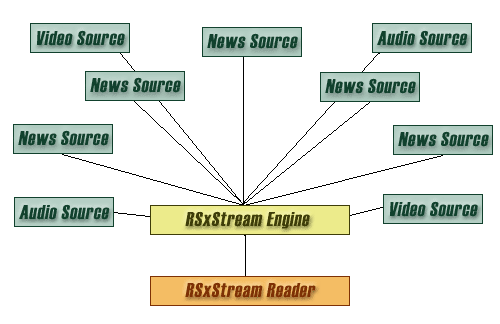 |
→ June 2004 Contents → Column
|
TV News in a Postmodern World
The Busine$$ of RSS June 2004
|
 |
|
For obvious reasons, those toy guns are now history, but the lesson continues teaching — especially today, when technological advances are occurring with such speed that it's difficult to keep up. So it is with all things Internet, and especially as they relate to the news business. Just as we're beginning to get comfortable with the idea of Websites and what to do with them, along comes this thing called RSS, and it threatens to be the granddaddy of all disruptive technologies. To review, RSS stands for Rich Site Summary or Real (or Really) Simple Syndication, depending on whom you ask. It's used to syndicate news content or any kind of text subject matter that is regularly updated. It speaks in the Internet dialect of Extensible Markup Language (XML), and here's how it works. Let's say I want to make my editorial content available to as many people as possible, so I create an XML version of each story's first 30 words and publish it on my Website (software does this automatically). Then, let's assume that you are interested in my news, so you obtain a simple — and in many cases, free — piece of software called a news aggregator. You give it the address of my XML file and, voila! Every time I load a new story, your news aggregator alerts you that it's there. You are automatically informed every time a new story posts on my Website. You can read — on your desktop — the first 30 words or so and decide if you want to click on a link to read more. As each day passes, more RSS news feeds become available. Reuters, for example, just made all of their news items available via RSS. KOMO-TV in Seattle has done likewise, and I think every local news entity will soon follow. Bill Gates told 100 top CEOs that RSS content syndication is a "very interesting phenomenon" and added, "It's getting away from the drawbacks of e-mail and the drawbacks of a Web site. We're progressively getting better and better at it." As a regular consumer of news, I can tell you that there's nothing quite like my simple little news aggregator. The news comes to me instead of me going to it. It's enormously time saving for me, to say nothing of what it has done in terms of broadening the scope of my information reach. I keep track of many news outlets and blogs this way. It's simply a marvelous technology for news. "This is all fine and dandy," news executives say (as they pray they won't have to learn yet another new technology), "but where's the money in RSS aggregators? Where's the business model?" In order to understand that, we really must stop thinking of the Internet in linear terms. That's hard for broadcasters, because the thing just looks like it ought to function like TV. I mean, we have a Website that "broadcasts" to people around the world. Whoever makes the most compelling and useful Website attracts the most people, and money follows eyeballs, right? We use our TV station to drive traffic to the site. That brings more people. That means more money, because, after all, more people is what advertisers want. This is what I call broadcast linear thinking, and the problem is the paradigm doesn't fit the Internet. The Web is vastly more sophisticated than that, and in terms of structure and function, it's actually quite the opposite of broadcasting. Unlike your TV station, the news Website you operate doesn't really exist as a place. It's a bunch of code files stored on a server somewhere that doesn't come to life until a desktop device calls for it. The browser doesn't "visit" the Website. It's the other way around. The Website comes to the browser when it's called. This is the secret that those of us who work in the industry understand but is awfully darned hard to communicate to broadcasters. This is why the reality of the Internet is so much easier to see with RSS. It uses a different type of desktop device (an aggregator) to do the same thing that a browser does — only without all the extra bells, whistles and blather that comes with bringing an entire bloody Website to your desktop. It brings you only what you want — at least, that's what it does today. Want a glimpse of tomorrow? Innovators Bill French and Harry Hayes are SmartStream Alliance™ and have a product that's so compelling that news executives of every sort will be scrambling to be first in their market with it. The RSS world of today is primarily end-user-to-provider, as illustrated below. The end user acquires an RSS aggregator and programs it to draw feeds directly from news sources. The sources are generally news providers and bloggers.
 RSxStream is a sophisticated and ingenious software engine that takes RSS, Atom, RDF, XML, any other sort of feed or data stream, or any other content that lives on the Internet and makes it available to the desktop via a contextual reader. End users are given a state-of-the-art reader — capable of grabbing anything from live TV to music to video-on-demand to simple RSS text feeds. If it's available via the Internet (today), it can be routed through the RSxStream engine. The end users have complete control of what sources they choose, as they would with any other RSS reader. The difference is those choices are drawn indirectly, through the RSxStream software.
 What's crucial to understand with this is that whoever provides the reader to the public also owns the engine, and THAT is the business end of RSS. It means advertising can be crafted into the design of the reader and delivered based on the choices, habits and interests of the end user. It's contextual advertising nirvana. This type of business currently does not exist, but it's ideal for local media outlets. Why? Because we're in the information distribution business, and getting the reader onto the public's desktops is the key to its success. Moreover, if the local media entities don't do it, somebody else will, and they will take all those ad dollars with them. Bill French of MyST Technologies in Denver is a former TV guy, who explained his lack of interest in television in a recent commentary on the MyST Website.
I watch much less television news now that RSS has come upon the scene. Why? Because it's more efficient for me to have relevant news find me in exactly the context that I appreciate most. My 10 o'clock 9 News (KUSA, Denver) delivers a blob of news that I must drink all at once and on their schedule. TiVo allows me to escape the scheduling issue but also encourages me to skip over the sponsors. ;-) Regardless, I haven't TiVo'd an affiliate or network news program more than five times in the three years I've had TiVo. Harry Hayes, CEO of Sausage Software in Bellingham Washington, has provided the industry with web creation tools like the HotDog series of HTML editors and Flash creation software for the last ten years. His company has built the soon-to-be-released reader for John Kerry's campaign. Hayes says Flash is the ideal technology for the RSxStream, because it's simple, flexible, dynamic and functions across all computer platforms. "Everything is just content to us," Hayes explains. "We're simply trying to help you get at the content you want, anywhere, anyplace, and anytime." What's in the future? "For now," he says, "we provide an end to end intelligent automated content management system that makes the information available and accessible in a branded program on any desktop regardless of platform." He calls it, "Content in context at the right point of contact." Ultimately, it could be the vehicle that seamlessly connects the Internet, your media and last but not least your refrigerator. The FCC's willingness to play "anything goes" with distribution systems, the rapid growth of broadband, and consumer demands driven by human nature (I want what I want when I want it) are the spring-loaded bullets of today's Internet Fanner 50s. Not only is the broadcast model outdated, but now it appears even the Website concept is under attack. Can phaser weaponry be far behind? © Terry L. Heaton
|
|
|
Write a Letter to the Editor
Join our Mailing List
© The Digital Journalist
|

 For the uneducated, cap guns made a sound like a real gun, because the ammunition was small bits of gun powder called "caps." Unfortunately, I got my Wyatt Earp Double Holster Fanner 50s just as the company was launching a new line that actually fired spring-loaded plastic bullets in addition to the caps. It didn't take long for my guns to be obsolete. How can you win a gunfight without bullets? It was my first experience with disruptive innovations.
For the uneducated, cap guns made a sound like a real gun, because the ammunition was small bits of gun powder called "caps." Unfortunately, I got my Wyatt Earp Double Holster Fanner 50s just as the company was launching a new line that actually fired spring-loaded plastic bullets in addition to the caps. It didn't take long for my guns to be obsolete. How can you win a gunfight without bullets? It was my first experience with disruptive innovations.